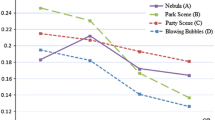Abstract
The availability of cheap network based video cameras and the prevalence of wireless networks has lead to a major thrust towards deployment of large scale Distributed Video Surveillance (DVS) systems. This has opened up an important area of research to deal with the issues involved in DVS system for efficient collection and transmission of large scale video streams from the cameras at the guarded sites, to the end users in possibly constrained network conditions. In this paper, we propose a framework based on content-based video classification and scalable compression scheme to provide a robust bandwidth efficient video transmission for DVS. The scheme builds on a Discrete Wavelet Transform (DWT) based Color-Set Partitioning for Hierarchical Trees (CSPIHT) coding to obtain a scalable bitstream. Wavelet domain segmentation and compression assists in development of a DVS architecture. The architecture includes a novel module for dynamic allocation of Network bandwidth based on the current available resources and constraints. Different frame constituents are optimally coded based on their relative significance, perceptual quality, and available estimate of network bandwidth. Experimental result over different video sequences and simulations for Network conditions demonstrate the efficient performance of the approach.









Similar content being viewed by others
References
Choi SJ, Woods J (1999) Motion-compensated 3-d subband coding of video. IEEE Trans Image Process 8(2):155–167. doi:10.1109/83.743851
Christopoulos C, Skodras A, Ebrahimi T (2000) The JPEG2000 still image coding system: an overview. IEEE Trans Consum Electron 46(4):1103–1127
Delp E, Salama P, Asbun E, Saenz N, Shen K (1999) Rate scalable image and video compression techniques. In: 1999 42nd midwest symposium on circuits and systems, vol 2, pp 635–638. doi:10.1109/MWSCAS.1999.867718
Doulamis A, Tziritas G (2006) Content-based video adaptation in low/variable bandwidth communication networks using adaptable neural network structures. In: International joint conference on neural networks (IJCNN ’06), pp 4037–4044
Huang JC, Hsieh WS (2003) Wavelet-based moving object segmentation. Electron Lett 39(19):1380–1382
Javed O, Rasheed Z, Alatas O, Shah M (2003) KNIGHT: a real-time surveillance system for multiple overlapping and non-overlapping cameras. In: Proceedings of the IEEE international conference on multimedia and expo, ICME’03, pp 649–652
Kim C, Hwang JN (2002) Object-based video abstraction for video surveillance systems. IEEE Trans Circuits Syst Video Technol 12(12):1128–1138
Leo M, Spagnolo P, D’Orazio T, Distante A (2004) Human activity recognition in archaeological sites by hidden markov models. PCM 2:1019–1026
Liu Y, Ngan KN (2007) Fast multiresolution motion estimation algorithms for wavelet-based scalable video coding. ACM Image Commun 22(5):448–465
Mahonen P (1999) Integration of wireless networks and AVS: advanced video based surveillance systems. Kluwer Academic Publishers
Mitchell J, Pennebaker W, Fogg C, Legall D (1996) MPEG video compression standard. Chapman & Hall, London, UK
Niu W, Jiao L, Han D, Wang Y (2003) Real-time multi-person tracking in video surveillance. In: Proceedings of the pacific rim multimedia conference, vol 2, pp 1144–1148
Pande A, Zambreno J (2011) Poly-DWT: polymorphic wavelet hardware support for dynamic image compression. ACM Trans Embed Comput Syst, in press
Pavlidis I, VMorellas, Tsiamyrtzis P, Harp S (2001) Urban surveillance systems: from the laboratory to the commercial world. In: Proceedings of IEEE, vol 89(10)
Qiu R, Yu W (2001) An efficient quality scalable motion-jpeg2000 transmission scheme. Tech Rep WUCS-01-37, Department of Computer Science, Washington University in St Louis. citeseer.ist.psu.edu/qiu01efficient.html
Richardson I (2003) H.264 and MPEG-4 video compression: video coding for next-generation multimedia. Wiley, New York
Richardson I (2003) H.264 and MPEG-4 video compression: video coding for next generation multimedia. Wiley, New York
Sacchi C, Regazzoni CS (1999) Multimedia communication techniques for remote cable based video-surveillance systems. In: International conference on image analysis and processing, pp 1100–1103
Said A, Pearlman W (1996) An image multiresolution representation for lossless and lossy image compression. IEEE Trans Image Process 5:1303–1310
Schwarz H, Marpe D, Wiegand T (Sept. 2007) Overview of the scalable video coding extension of the h.264/avc standard. IEEE Trans Circuits Syst Video Technol 17(9):1103–1120. doi:10.1109/TCSVT.2007.905532
Shapiro J (1993) Embedded image coding using zerotrees of wavelet coefficients. IEEE Trans Signal Process 41(12):3445–3462
Shapiro JM (1993) Embedded image coding using zerotrees of wavelet coefficients. IEEE Trans Signal Process 41(12):3445–3462
Stauffer C, Grimson W (1999) Adaptive background mixture models for real-time tracking. In: Proceedings IEEE conf computer vision and pattern recognition, vol 2, pp 246–252
Taubman D (2000) High performance scalable image compression with EBCOT. IEEE Trans Image Process 9(7):1158–1170
Toreyina BU, Cetina AE, Aksay A, Akhan MB (2004) Moving object detection in wavelet compressed video. Signal Process Image Commun 20:255–264
Vetro A, Haga T, Sumi K, Sun H (2003) Object-based coding for long-term archive of surveillance video. In: Proceedings of international conference on multimedia & expo (ICME), vol 2, pp 417–420
Wiegand T, Sullivan GJ, Bjntegaard G, Luthra A (2003) Overview of the H.264/AVC video coding standard. IEEE Trans Circuits Syst Video Technol 13(7):560–576
Yang W, Lu Y, Wu F, Cai J, Ngan KN, Li S (2006) 4-d wavelet-based multiview video coding. IEEE Trans Circuits Syst Video Technol 16(11):1385–1396. doi:10.1109/TCSVT.2006.884571
Author information
Authors and Affiliations
Corresponding author
Rights and permissions
About this article
Cite this article
Kumar, P., Pande, A. & Mittal, A. Efficient compression and network adaptive video coding for distributed video surveillance. Multimed Tools Appl 56, 365–384 (2012). https://doi.org/10.1007/s11042-010-0672-2
Published:
Issue Date:
DOI: https://doi.org/10.1007/s11042-010-0672-2




